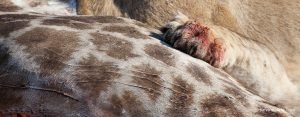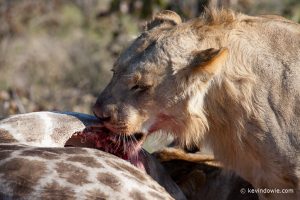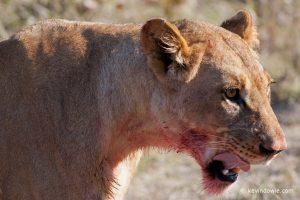One of the interesting things we observed during my 2009 trip to Botswana was a pride of sub-adult lions on a freshly killed giraffe. Our guide had tracked the lions through the bush to the kill location. He estimated that the kill had been made probably 15 minutes or so before our finding it. I prepared a photo essay on the subject which I have republished here. Be warned that some of the shots are a bit gruesome.
Early morning in Botswana in July, 2009, near Savuti Channel in the Okavango Delta and a group of lions had chased and killed a giraffe. Our guide had observed some lion tracks near the water’s edge and from this, and the puddles of water on the bank deduced that the lions had crossed through the water only a few minutes before us. The next 30 minutes or so showed the value of both our guides’ local knowledge and tracking skills as we made our way in the four-wheel-drive through the scrub until we finally came across the group on a giraffe kill.
From the tracks, we know that the lions had located and given chase to some zebras but were unable to catch them. Good fortune for the zebra but bad luck for a giraffe. The lions chased, brought down and killed, a heavily pregnant female, presumably with her extra weight she was the slowest.
One of the photographs tells part of the story, the claw marks on the rump of the giraffe show how the lions have jumped onto the rear and back of their prey to drag it down.
Bringing down an adult giraffe is no easy matter for lions. As it runs the giraffe flicks its hooves out and can cause serious injury to a lion. Having made the kill, the lions then commence by eating at the crutch of the animal and opening up the abdomen to get at the internal organs. In this case, opening up the abdomen also allowed the lions to drag away the unborn calf. Just out of frame to the right, other lions were feeding on the calf which appeared to be fully developed and probably not far away from being born.
From memory, the group consisted of 11 lions, 9 males and 2 females, all of them sub-adults. Some of the males display the early stages of growing manes. Whilst a pride will consist of one, possibly two adult males, with a collection of females and the resulting cubs. Males, whether sub-adults as in this case or adults without a pride, will sometimes form coalitions, cooperating in hunting and hence improving their chances of survival.
It’s long been believed that within a pride, the females will do the bulk of the hunting with the male or males playing little if any part. Recent research and observation suggest however that males may be more heavily involved in hunting activity than previously thought.
Lions are unique among the cats in that they are communal animals and cooperative hunters, also in that there are obvious gender differences in their physical appearance. A pride will consist of several related females with one or two adult males. The role of the males is to patrol and scent mark the pride’s territory and fend off other males that may try and enter the pride. The home range of a pride can vary in size between 20 and 400 square kilometres depending on the conditions and availability of prey.
Cubs are typically born after a gestation period of 110 days with it being common for several females in the pride to give birth at about the same time. A lioness will generally give birth in a secluded location away from the pride and then introduce the cubs into the pride at about 8 weeks of age. At 3 months of age, cubs will accompany the lioness to a kill to eat and will start learning how to hunt at 11 or 12 months of age. Females will share the duties of protecting and nursing cubs within the pride and will usually be ready to breed again when the cubs are about 2 years old.
Males upon taking over a pride by chasing off, or forcing out the established male who may have become old or weaker, will generally kill any cubs within the pride. By doing so, the females will come back into estrus and are ready to breed with the new dominant male or males.
Threats and Survival Status.
It is variously estimated that there are now between 10,000 and 25,000 free lions in Sub-Saharan Africa with 2 different subspecies being recognized. The West African subspecies which is now regarded as “endangered” and the Eastern and Southern African subspecies which is regarded as “vulnerable”. There has been a decline in numbers from an estimated 100,000 2 decades ago, the reasons include so-called “sports” or “trophy” hunting, loss of habitat and human development. Approximately 1500 lions are killed in hunting per annum in Southern Africa alone with about 100 lions per year being killed as a “livestock protection” measure.
The effects of hunting go beyond the killing of the individual animal. It’s believed that for each adult male shot a total of 6 to 8 lions will die as a result. The reason being that the male having been killed will then be replaced in its pride by one or more other males who, as discussed earlier, will kill the cubs within the pride so as to prompt their own turn at breeding. In addition, lions are susceptible to several different diseases which can severely impact numbers. These include canine distemper, bovine tuberculosis and FIV the feline equivalent of human HIV.
Suggested further reading…… African Wildlife Foundation.







